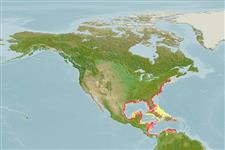Bivalvia |
Pectinida |
Pectinidae
Environment: milieu / climate zone / пределы глубины / distribution range
экология
; пределы глубины 0 - 20 m (ссылка 83435), usually ? - 10 m (ссылка 113981). Tropical; 24°C - 26°C (ссылка 113981), preferred 20°C (ссылка 107945); 45°N - 8°N, 98°W - 66°W
Western Atlantic: Argopecten irradians irradians, Argopecten irradians concentricus, Argopecten irradians amplicostatus. Introduced in Canada and China.
Length at first maturity / Size / Weight / Возраст
половая зрелость: Lm ? range ? - ? cm Max length : 7.5 cm SHL самец/пол неопределен; (ссылка 344); наибольший возраст (опубликованны данные): 3.00 годы (ссылка 126617)
Shell valves convex, upper valve less convex than more inflated lower valve. Surface sculpture of 19 to 21 strong, squarish ribs. Hinge with wing-like projections of about same size. Colour: lower valve light, usually whitish, upper valve dark brown to dark grey with darker markings.
Average life span of 20 to 26 months. Form beds on sandy, eelgrass or other seagrass bottoms (Ref. 344).
Spawns after 1 year of age, during mass-spawning events that take place almost always in July (Ref. 344).
Основная ссылка
ссылки | координатор | соавторы
Leal, J.H. 2003 Bivalves. p. 25-98. In Carpenter, K.E. (ed.). The living marine resources of the Western Central Atlantic. Volume 1: Introduction, molluscs, crustaceans, hagfishes, sharks, batoid fishes, and chimaeras. FAO Species Identification Guide for Fishery Purposes and American Society of Ichthyologists and Herpetologists Special Publication No. 5. 1600p. (ссылка 344)
Статус Красного Списка МСОП
(ссылка 130435: Version 2025-1)
Статус СИТЕС (ссылка 108899)
Not Evaluated
CMS (ссылка 116361)
Not Evaluated
Угроза для людей
Использование человеком
рыболовство: коммерческий; аквакультура (рыбоводство): коммерческий
FAO - рыболовство: landings | FishSource | Sea Around Us
инструменты
дополнительная информация
PhysiologyOxygen consumption
Human RelatedStamps, coins, misc.
ресурсы в Интернет
Estimates based on models
Preferred temperature
(Ref.
115969): 9.7 - 12.7, mean 11.7 (based on 22 cells).
Fishing Vulnerability
Low vulnerability (15 of 100).
Climate Vulnerability
Very high vulnerability (77 of 100).
Nutrients : Calcium = 149 [71, 228] mg/100g; Iron = 8.53 [1.95, 15.11] mg/100g; Protein = 9.88 [8.64, 11.12] %; Omega3 = 0.313 [0.202, 0.423] g/100g; Selenium = 61 [50, 72] μg/100g; VitaminA = 0 μg/100g; Zinc = 2.04 [0.56, 3.51] mg/100g (wet weight); based on
nutrient studies.
